|
|
|
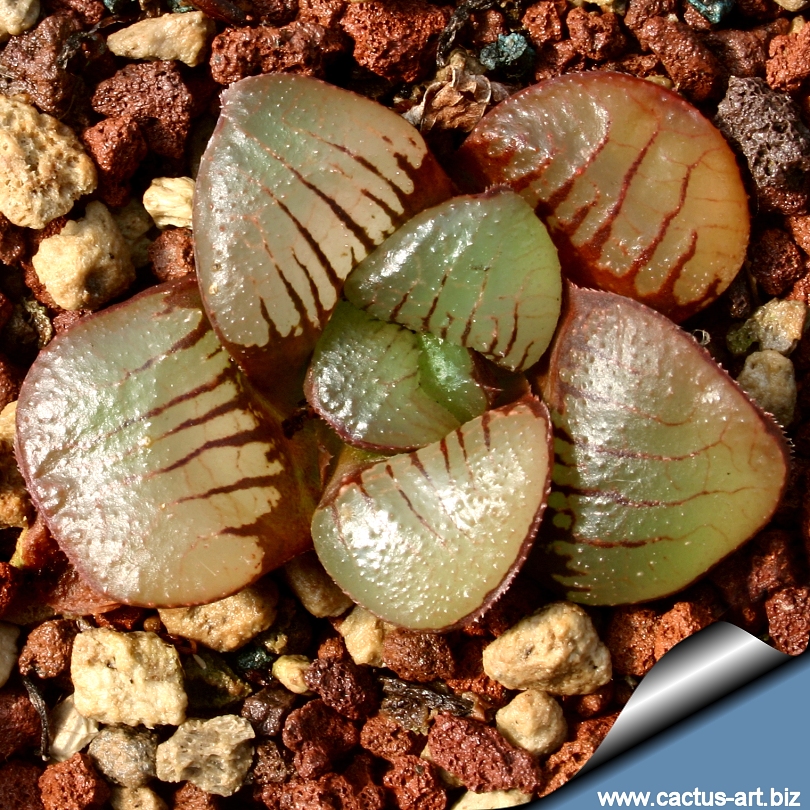
Haworthia springbokvlakensis
The transparent leaves of this little botanical treasure have characteristic
fine purple-brown stripes and grows almost flat to the ground.
|
|
Description:
Haworthia springbokvlakensis is a tiny perennial- succulent with
retuse leaves almost flat to the ground.
Stem: Stemless.
Rosettes: This species is very slow growing and forms a solitary
few-leaved rosette 7 to 10 cm in diameter, each rosette has only 8 to 12
leaves.
Leaves: 3,5-6 cm long
and about 1,5 cm large, retuse, turgid grey-green to greyish-pink with
translucent "windows" ornamented with characteristic fine purple-brown
pattern of (usually) not-branched striations on the terminal part. They
are more or less smooth with very small tubercles the same colour of the
leaf. Minute teeth are found on the margin.
Flowers: Flowers are borne on a slender inflorescence up to 25 cm
tall, they are whitish, the petals have a darker brown mid-line.
|
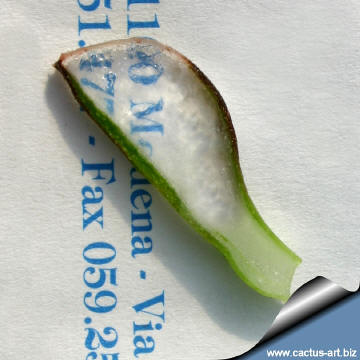 |
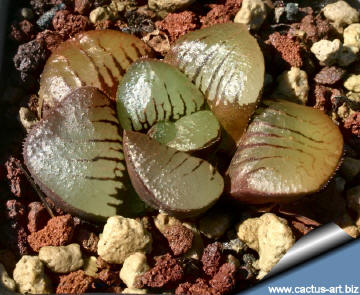
The fenestrate leaves have a nearly transparent flat apex exposed to the
sun and are even at the soil level. This permit the plants to minimize
the heating effects and to reduce the drying effects of drought.
|
|
.
|
 |
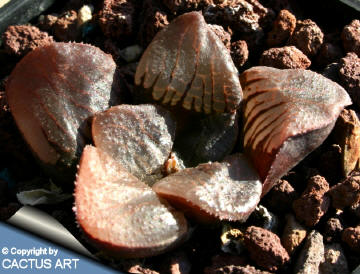
The disadvantage is the limited amount of leaf surface area
exposed to the sun, but the fenestration allow sunlight to be captured
and utilized even when the plant are retracted below the surface of the
soil. |
|
.
|
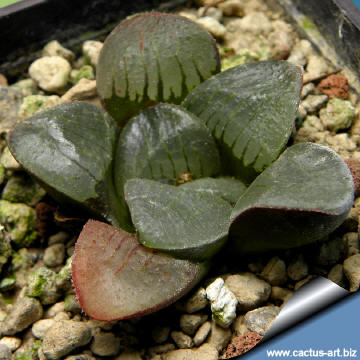 |
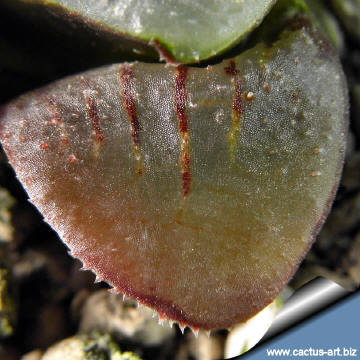 |
|


Advertising
|
|
|
|
|
Family:
Asphodelaceae (Aloacee - Liliaceae)
Scientific name: Haworthia springbokvlakensis
C.L.Scott
Published in: Journ. S. Afr. Bot. xxxvi. 288 (1970).
Origin:
South Africa (Eastern cape, East of Little Karoo)
Habitat:
A limited number of plant were
found scattered on a small hill in the dry interior West Cape around
Oudtshoorn where the population density was never very high. In this
area the rain is scant but can occur in winter or summer. They grows
almost buried with only the upper retuse face of the leaves visible, on
a firm hard gravely soil with pH 6,8 in the protection of shrubs often
in deep shade and covered with dust.
Etymology: The
species has been named spingbokwlakensis for the
occurrence on one of dozen or more places named Spingbokvlatke in
Little Karro region (South-Africa). The name Springbokvlakte indicates a
"flats where the springboks are found" (Springbok are South
African gazelle noted for springing lightly into the air)
Synonyms:
- Haworthia retusa
var. springbokvlakensis
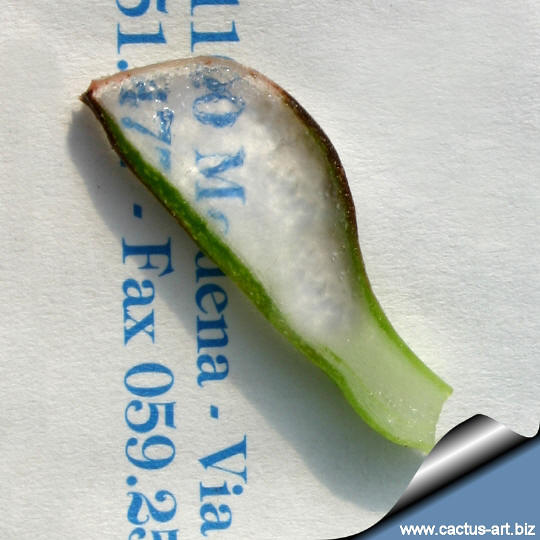
A leaf slice showing the translucent
tissues.
|
|
|
|
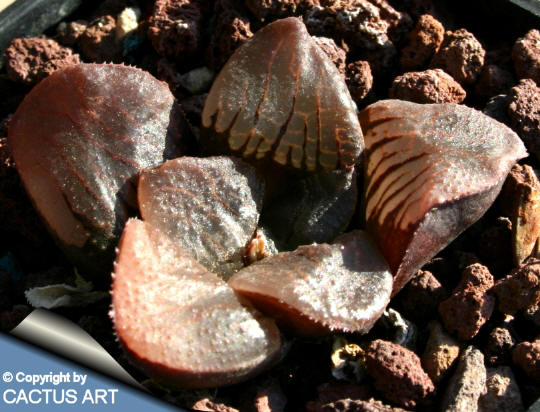
Fenestrate
growth habit
.
A number of South African
succulents like
Lithops ssp. and
Haworthia ssp. to escape the
killing
heat of the
desert
grow almost entirely
subterranean and have
evolved special
fenestrate
leaves that
grow below the
surface of the soil;
This
succulent
leaves have a nearly
transparent flat
apex
exposed to the
atmosphere and are even
at the soil level. This
permit the
plants to minimize the
heating effects of high
light intensity and to reduce the
drying effects of
desert
air during
prolonged
drought. There are no
stomata in the windows, so
little
water is lost, these plants remain
subterranean because
they have
contractile roots which continually pull the plants
deeper into the
ground as the
stem
elongates.
The disadvantage, however, is the limited amount of
leaf
surface
area
exposed to the
sun for
photosynthesis to supply
food for
the plant but the
translucent window in the top
surface,
however, the fenestration allow
sunlight to be captured and utilized even when
the plant are
retracted below the
surface of the soil. This is
an interesting evolutionary
adaptation to overcome this
light
problem; their
leaves are a simple optical system that permits
light striking the windows to be
diffused onto the green,
photosynthesizing surface situated
underground. So, with a minimum
of
exposure to the outside
environment, a maximum area of
photosynthetic
tissue is ensured.
Propagation: Usually by seeds or offsets that occasionally
appear at the base
between the leaves;
leave them attached until they are 1/3 the size of the parent and then
detach and plant.
Cultivation: This is one of the
choicest but slow growing of the retuse-leaved haworthias.
Need regular water but do not water again until dry. Also, it is a
species that is dormant in the winter and require very little water
(maybe even none) during the cold months.
Frost Tolerance: Light frost protection
required. Minimum of 5ºC for safe growing (but hardy up to -5°C or
less.)
Sun Exposure: Some shade is also in
order, as the plants grows
typically under the protection of bushes.
Can be sunburned if moved from shade/greenhouse into full sun too
quickly. The amount of sunlight it can withstand without scorching
depends upon the how hot it becomes in the summer in the locale in which
it is planted. It will have more colour if it receives more light.
During the spring it may be able to take some sun until the heat arrives
at the end of spring. In an area that has hot afternoon sun, it may be
able to take full morning sun, but requires afternoon shade or afternoon
light shade. |
|